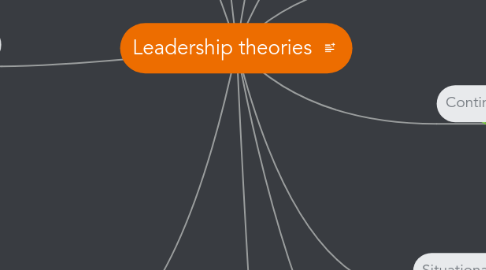
1. Great Man Theory
1.1. Born with innate qualities
1.2. destined to lead
1.3. Until the latter part of the twentieth century leadership was thought of as a concept which is primarily male, military and Western
2. Trait Theory
2.1. (It) draws on virtually all the adjectives in the dictionary which describe some positive or virtuous human attribute, from ambition to zest for life
2.2. Traits are hard to measure
2.3. acquire leaders through traits not skills
2.4. common to the military
2.5. No consistent traits were found in many studies
2.6. 'some' or no traits did not mean you were a leader
2.7. Leadership skills & traits
3. Behaviourist Theory
3.1. This concentrates on 'doing' rather than personal qualities
3.2. Theory Models
3.2.1. focussed on human relationships
3.2.2. focussed on output & performance
3.2.3. McGregor’s Theory X & Theory Y Managers
3.2.3.1. A leader holding Theory X assumptions would prefer an autocratic style, whereas one holding Theory Y assumptions would prefer a more participative style
3.2.4. Blake and Mouton's Managerial Grid
3.2.4.1. Five leadership styles
3.2.4.1.1. Country Club Management
3.2.4.1.2. Team Management
3.2.4.1.3. Organisation Man Management
3.2.4.1.4. Impoverished Management
3.2.4.1.5. Authority Obedience
3.2.4.2. Focuses on task (production) and employee (people) orientations of managers
3.3. The results of the trait studies were inconclusive.
4. Early theories
4.1. characteristics
4.2. behaviours
5. Contingency or Situational Theory
5.1. Contingency-situational theories were developed to indicate that the style to be used is contingent upon such factors as the situation, the people, the task, the organisation, and other environmental variables
5.2. Theory Models
5.2.1. Fiedler's Contingency Model
5.2.1.1. There is no single best way for managers to lead. Situations will create different leadership style requirements for a manager.
5.2.1.2. Three situations that could define the condition of a managerial task: 1. Leader member relations: How well do the manager and the employees get along? 2. Task structure: Is the job highly structured, fairly unstructured, or somewhere in between? 3. Position power: How much authority does the manager possess?
5.2.2. Hersey-Blanchard Model of Leadership
5.2.2.1. The developmental levels of a leader's subordinates play the greatest role in determining which leadership styles (leader behaviours) are most appropriate
5.2.2.2. Directing: The leader provides clear instructions and specific direction. This style is best matched with a low follower readiness level.
5.2.2.3. Coaching: The leader encourages two-way communication and helps build confidence and motivation on the part of the employee, although the leader still has responsibility and controls decision making. Selling style is best matched with a moderate follower readiness level.
5.2.2.4. Supporting: With this style, the leader and followers share decision making and no longer need or expect the relationship to be directive. Participating style is best matched with a moderate follower readiness level.
5.2.2.5. Delegating: This style is appropriate for leaders whose followers are ready to accomplish a particular task and are both competent and motivated to take full responsibility. Delegating style is best matched with a high follower readiness level.
5.2.2.6. To determine the appropriate leadership style to use in a given situation, the leader must first determine the maturity level of the followers in relation to the specific task that the leader is attempting to accomplish through the effort of the followers.
5.2.3. Tannenbaum & Schmidt’s Leadership Continuum
5.2.3.1. leadership behaviour varies along a continuum and that as one moves away from the autocratic extreme the amount of subordinate participation and involvement in decision taking increases.
5.2.4. Adair’s Action-Centred Leadership Model
5.2.4.1. The action-centred leader gets the job done through the work team and relationships with fellow managers and staff
5.2.4.2. An action-centred leader must: • direct the job to be done (task structuring) • support and review the individual people doing it • co-ordinate and foster the work team as a whole
6. Situational Leadership
6.1. leadership 'style' is flexible
6.2. leadership is specific to the situation
6.3. different styles at different levels in one organisation
7. Contingency Theory
7.1. a refinement of Situational Leadership
7.2. It identifies situational variables that predict the most appropriate/effective leadership style in a given circumstance
8. Transactional Therory
8.1. relational importance between leader and follower
8.2. mutual benefits of working together
8.3. rewards/recognition for commitment/loyalty
9. Transformational Theory
9.1. central concept is change
9.2. envisioning & implementing transformation of organisational performance
10. Later theories
10.1. followers
10.2. leadership in context of situations
11. Leaders and Followers
11.1. Servant Leadership
11.1.1. Doing real work in support of others instead of only the reverse
11.1.2. the leaders’ duty to serve his/her followers - leadership thus arises out of a desire to serve rather than a desire to lead
11.2. Following Leadership
11.2.1. Asking questions instead of giving answers
11.2.2. Providing opportunities for others to lead you
11.2.3. Becoming a matchmaker instead of a "central switch"
11.2.4. Seeking common understanding instead of consensus
